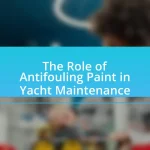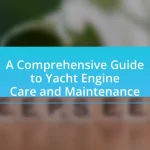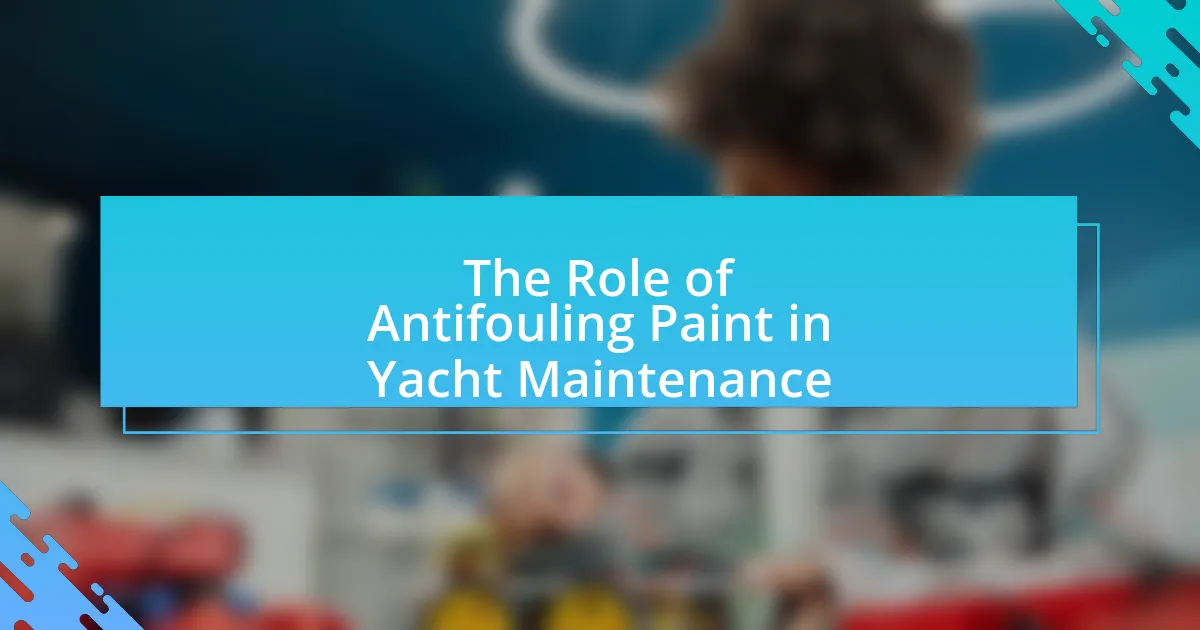Essential winterization tips for your yacht are crucial for protecting the vessel from damage during cold months. Key steps include draining water systems, adding antifreeze, and properly storing the battery to prevent freezing and ensure functionality. The article emphasizes the importance of winterization to avoid costly repairs and extend the yacht’s lifespan, detailing risks such as ice accumulation and structural damage. It also outlines best practices for maintaining the yacht during winter, including regular inspections and the use of appropriate materials and tools for effective winterization.

What are Essential Winterization Tips for Your Yacht?
Essential winterization tips for your yacht include draining the water systems, adding antifreeze, and properly storing the battery. Draining the water systems prevents freezing and potential damage, while adding antifreeze protects the engine and plumbing. Properly storing the battery ensures it remains charged and functional for the next season. These steps are crucial for maintaining the yacht’s integrity and performance during winter months.
Why is winterization important for your yacht?
Winterization is important for your yacht because it protects the vessel from damage caused by freezing temperatures and harsh weather conditions. Proper winterization involves draining water systems, adding antifreeze, and securing the yacht to prevent structural damage. According to the National Marine Manufacturers Association, failure to winterize can lead to costly repairs, with potential damage to engines, plumbing, and hull integrity. This preventative maintenance ensures the yacht remains in optimal condition for the next boating season.
What risks does a yacht face during winter months?
A yacht faces several risks during winter months, including damage from freezing temperatures, ice accumulation, and increased wear from harsh weather conditions. Freezing temperatures can lead to the freezing of onboard water systems, which may cause pipes to burst and result in costly repairs. Ice accumulation on the hull can affect stability and maneuverability, while harsh weather can lead to structural damage or wear on sails and rigging. According to the National Marine Manufacturers Association, proper winterization is essential to mitigate these risks and ensure the yacht remains in good condition for the following season.
How can proper winterization extend the life of your yacht?
Proper winterization can significantly extend the life of your yacht by protecting it from harsh winter conditions that can cause damage. This process involves steps such as draining water systems to prevent freezing, applying protective coatings to the hull, and storing the yacht in a climate-controlled environment. For instance, according to the National Marine Manufacturers Association, proper maintenance and winterization can reduce repair costs by up to 30% over time. By preventing issues like corrosion, mold growth, and structural damage, winterization ensures that the yacht remains in optimal condition, ultimately prolonging its lifespan and maintaining its value.
What are the key steps in the winterization process?
The key steps in the winterization process for a yacht include cleaning the exterior and interior, draining and winterizing the engine and plumbing systems, adding antifreeze, removing and storing the battery, and covering the yacht to protect it from the elements. Cleaning the yacht prevents mold and mildew, while draining the engine and plumbing systems avoids damage from freezing temperatures. Adding antifreeze to the engine and plumbing systems ensures they remain functional. Removing the battery prevents discharge and damage, and covering the yacht protects it from snow and ice accumulation. These steps are essential to maintain the yacht’s condition during winter months.
How do you prepare the engine for winter?
To prepare the engine for winter, you should perform a thorough inspection and maintenance routine. This includes changing the oil and oil filter to prevent sludge buildup, checking and replacing the fuel filter to ensure clean fuel flow, and adding a fuel stabilizer to prevent fuel degradation during storage. Additionally, you should flush the cooling system and replace the antifreeze to protect against freezing, inspect the battery and clean terminals, and ensure all hoses and belts are in good condition to avoid failures in cold weather. These steps are essential as they help maintain engine performance and longevity during winter months.
What should you do with the fuel system during winterization?
During winterization, you should add a fuel stabilizer to the fuel system. This stabilizer prevents the fuel from degrading and forming varnish or gum, which can clog fuel lines and filters. Additionally, it is essential to fill the fuel tank to minimize condensation, which can lead to water accumulation and fuel contamination. According to the National Marine Manufacturers Association, using a fuel stabilizer can extend the life of the fuel and ensure optimal engine performance when the yacht is re-commissioned in the spring.
How can you protect the electrical systems on your yacht?
To protect the electrical systems on your yacht, install high-quality circuit breakers and fuses to prevent overloads and short circuits. These devices act as safeguards, cutting off power when excessive current flows, thus protecting wiring and equipment from damage. Additionally, regularly inspect and maintain connections and wiring for corrosion, as saltwater environments can accelerate deterioration. Using marine-grade components designed for harsh conditions further enhances durability and reliability. Implementing these measures can significantly reduce the risk of electrical failures and ensure safe operation during winterization and beyond.
What materials and tools are needed for winterization?
To winterize a yacht, essential materials and tools include antifreeze, a bilge pump, a hose, a vacuum pump, and a battery charger. Antifreeze is crucial for preventing freezing in the engine and plumbing systems, while a bilge pump helps remove any water that could freeze and cause damage. A hose is necessary for flushing the engine with antifreeze, and a vacuum pump is used to remove moisture from the fuel system. A battery charger ensures that the yacht’s batteries remain charged during the winter months. These materials and tools are vital for protecting the yacht from winter-related damage and ensuring its readiness for the next season.
What specific products should you use for winterizing your yacht?
To winterize your yacht effectively, you should use antifreeze, fuel stabilizer, and a moisture absorber. Antifreeze, specifically propylene glycol-based, prevents engine and plumbing system freeze damage. Fuel stabilizer, such as Stabil or Star Tron, keeps fuel fresh and prevents degradation during storage. A moisture absorber, like silica gel packs or DampRid, helps control humidity inside the yacht, preventing mold and mildew. These products are essential for protecting your yacht during winter months and ensuring it remains in good condition for the next season.
How do you choose the right tools for the winterization process?
To choose the right tools for the winterization process, assess the specific needs of your yacht and the tasks required for effective winterization. Essential tools typically include antifreeze for the engine and plumbing systems, a pump for draining water, and protective covers for the hull and sails. Selecting high-quality, marine-grade products ensures durability and effectiveness, as evidenced by the fact that using subpar materials can lead to costly damage during winter months. Additionally, consulting manufacturer guidelines for your yacht model can provide tailored recommendations for necessary tools, ensuring a comprehensive winterization process.

How do you execute the winterization process effectively?
To execute the winterization process effectively, begin by thoroughly cleaning the yacht, including the hull, deck, and interior, to prevent mold and mildew. Next, drain all water systems, including fresh water and waste tanks, to avoid freezing and damage. Additionally, add antifreeze to the engine and plumbing systems to protect against low temperatures. It is also crucial to remove and store any removable equipment, such as sails and electronics, in a dry place. Finally, cover the yacht with a breathable cover to shield it from snow and ice while allowing moisture to escape. These steps are essential to ensure the yacht remains in good condition during winter months.
What are the step-by-step instructions for winterizing your yacht?
To winterize your yacht, follow these step-by-step instructions:
- Clean the yacht thoroughly, removing all dirt, debris, and marine growth to prevent damage during winter.
- Drain all water systems, including fresh water, plumbing, and holding tanks, to avoid freezing and cracking.
- Add antifreeze to the engine, water systems, and any other areas where water could freeze, ensuring it is suitable for marine use.
- Disconnect and remove the battery, storing it in a cool, dry place to prevent discharge and damage.
- Inspect and service the engine, including changing the oil and filters, to ensure it is ready for the next season.
- Cover the yacht with a high-quality, breathable cover to protect it from snow, ice, and UV damage.
- Store the yacht in a safe location, preferably indoors, to shield it from harsh winter conditions.
These steps are essential for protecting your yacht from winter damage and ensuring it remains in good condition for the next boating season.
How do you drain the water systems properly?
To drain the water systems properly, first, turn off the water supply and open all faucets to allow air into the system. This action helps to release any remaining water in the pipes. Next, use a pump or gravity to remove water from the tanks and lines, ensuring that all water is expelled to prevent freezing and damage during winter. Additionally, consider using antifreeze specifically designed for marine systems to protect against freezing temperatures. This method is validated by marine maintenance guidelines, which emphasize the importance of thorough drainage to avoid costly repairs.
What is the best way to cover your yacht for winter?
The best way to cover your yacht for winter is to use a high-quality, breathable cover specifically designed for marine use. This type of cover protects the yacht from snow, ice, and moisture while allowing air circulation to prevent mold and mildew. Additionally, securing the cover tightly with straps or ropes ensures it remains in place during harsh winter weather. Using a breathable cover is essential, as non-breathable materials can trap moisture, leading to damage.
What common mistakes should you avoid during winterization?
Common mistakes to avoid during winterization include neglecting to properly clean and dry the yacht, which can lead to mold and mildew growth. Additionally, failing to drain all water systems can result in freezing and damage to pipes. Not using appropriate antifreeze in the engine and plumbing systems can cause severe mechanical issues. Lastly, overlooking the importance of inspecting and maintaining the hull can lead to deterioration and costly repairs. These mistakes can significantly impact the yacht’s condition and performance when it is re-launched.
How can neglecting certain areas lead to damage?
Neglecting certain areas of a yacht during winterization can lead to significant damage, such as structural deterioration and mechanical failure. For instance, failing to properly winterize the engine can result in freezing and cracking of engine components, which may lead to costly repairs. Additionally, neglecting to inspect and seal potential leaks in the hull can allow water intrusion, causing mold growth and weakening the vessel’s integrity. According to the National Marine Manufacturers Association, improper winterization can increase maintenance costs by up to 30% in the following season, highlighting the financial impact of neglect.
What are the signs of improper winterization?
Signs of improper winterization include water in the engine, which can lead to freezing and damage, and unprotected fuel systems that may cause corrosion or fuel degradation. Additionally, if there are leaks in the hull or fittings, it indicates inadequate sealing against winter conditions. Another sign is the presence of mold or mildew, suggesting insufficient ventilation and moisture control. Lastly, if the battery is not properly stored or maintained, it may fail to hold a charge come spring. These indicators highlight the importance of thorough winterization to prevent costly repairs and ensure the yacht’s longevity.

What are the best practices for maintaining your yacht during winter?
The best practices for maintaining your yacht during winter include proper winterization, regular inspections, and protective measures. Winterization involves draining water systems, adding antifreeze to prevent freezing, and ensuring fuel tanks are full to avoid condensation. Regular inspections should focus on checking for leaks, corrosion, and the condition of the hull and deck. Protective measures include using a high-quality cover to shield the yacht from snow and ice, and storing it in a climate-controlled environment if possible. These practices help prevent damage and ensure the yacht remains in optimal condition for the next season.
How can you monitor your yacht throughout the winter months?
To monitor your yacht throughout the winter months, utilize a combination of regular inspections, remote monitoring systems, and environmental controls. Regular inspections involve checking for signs of damage, leaks, or wear at least once a month, ensuring that any issues are addressed promptly. Remote monitoring systems, such as GPS trackers and onboard sensors, provide real-time data on the yacht’s location, battery levels, and environmental conditions, allowing for immediate alerts if any anomalies occur. Additionally, maintaining proper environmental controls, such as ensuring adequate ventilation and humidity levels, helps prevent mold and mildew, which can damage the yacht over time. These methods collectively ensure that the yacht remains in optimal condition during the winter months.
What checks should you perform regularly during winter storage?
During winter storage, you should regularly check the battery, engine fluids, and hull condition. Regularly inspecting the battery ensures it remains charged and functional, as cold temperatures can reduce battery performance. Checking engine fluids, including oil and coolant levels, prevents potential damage from freezing or contamination. Additionally, examining the hull for cracks or damage helps maintain structural integrity and prevents water intrusion, which can lead to further issues. These checks are essential for ensuring the yacht remains in optimal condition throughout the winter months.
How can you ensure your yacht remains in good condition until spring?
To ensure your yacht remains in good condition until spring, winterize it properly by following essential maintenance steps. First, clean the yacht thoroughly to remove dirt, salt, and grime, which can cause corrosion and damage over time. Next, drain all water systems, including the freshwater tank and plumbing, to prevent freezing and bursting during cold weather. Additionally, apply antifreeze to the engine and other critical systems to protect against freezing temperatures.
Cover the yacht with a high-quality, breathable cover to shield it from snow, ice, and UV damage while allowing moisture to escape. Store the yacht in a climate-controlled environment if possible, as this minimizes exposure to harsh weather conditions. Regularly check on the yacht throughout the winter months to address any issues promptly. These steps are supported by industry best practices, which emphasize the importance of proper winterization to extend the lifespan and maintain the functionality of marine vessels.
What resources are available for yacht winterization guidance?
Resources available for yacht winterization guidance include online guides, instructional videos, and professional services. Websites such as BoatUS and the American Boat and Yacht Council provide comprehensive articles and checklists detailing winterization steps. Additionally, YouTube hosts numerous tutorials from experienced boaters demonstrating the winterization process. Professional marine services also offer consultations and hands-on assistance, ensuring that yacht owners can effectively prepare their vessels for winter storage. These resources collectively ensure that yacht owners have access to reliable information and expert advice for proper winterization.
Where can you find professional winterization services?
You can find professional winterization services through marine service providers, yacht maintenance companies, and local boatyards. These businesses specialize in preparing yachts for winter by offering services such as engine winterization, antifreeze application, and hull protection. Many of these providers are listed in directories like the American Boat and Yacht Council or can be found through online searches for marine services in your area.
What online resources provide detailed winterization tips?
Online resources that provide detailed winterization tips for yachts include the American Boat and Yacht Council (ABYC) website, which offers comprehensive guidelines on boat maintenance and winterization practices. Additionally, the BoatUS website features articles and videos specifically focused on winterizing boats, covering essential steps and checklists. The National Marine Manufacturers Association (NMMA) also provides resources and best practices for winterizing recreational boats, ensuring that yacht owners can protect their vessels during the colder months. These resources are recognized within the boating community for their accuracy and thoroughness in addressing winterization needs.
What are the top winterization tips for yacht owners?
The top winterization tips for yacht owners include properly draining and winterizing the engine, protecting the hull, and ensuring all systems are secured against freezing temperatures. Draining the engine prevents water from freezing and causing damage, while applying antifreeze to the cooling system further safeguards against freezing. Protecting the hull involves cleaning and applying a protective wax or cover to prevent damage from ice and snow. Additionally, securing all systems, including plumbing and electrical, ensures they remain functional and safe during winter storage. These practices are essential for maintaining the yacht’s integrity and performance during the off-season.















